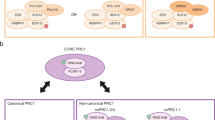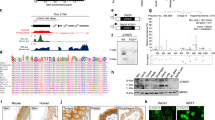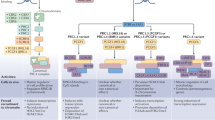Abstract
Carcinoma is an altered state of tissue differentiation in which epithelial cells no longer respond to cues that keep them in their proper position. A break down in these cues has disastrous consequences not only in cancer but also in embryonic development when cells of various lineages must organize into discrete entities to form a body plan. Paraxial protocadherin (PAPC) is an adhesion protein with six cadherin repeats that organizes the formation and polarity of developing cellular structures in frog, fish and mouse embryos. Here we show that protocadherin-8 (PCDH8), the human ortholog of PAPC, is inactivated through either mutation or epigenetic silencing in a high fraction of breast carcinomas. Loss of PCDH8 expression is associated with loss of heterozygosity, partial promoter methylation, and increased proliferation. Complementation of mutant tumor cell line HCC2218 with wild-type PCDH8 inhibited its growth. Two tumor mutants, E146K and R343H, were defective for inhibition of cell growth and migration. Surprisingly, the E146K mutant transformed the human mammary epithelial cell line MCF10A and sustained the expression of cyclin D1 and MYC without epidermal growth factor. We propose that loss of PCDH8 promotes oncogenesis in epithelial human cancers by disrupting cell–cell communication dedicated to tissue organization and repression of mitogenic signaling.
This is a preview of subscription content, access via your institution
Access options
Subscribe to this journal
Receive 50 print issues and online access
$259.00 per year
only $5.18 per issue
Buy this article
- Purchase on Springer Link
- Instant access to full article PDF
Prices may be subject to local taxes which are calculated during checkout





Similar content being viewed by others
Accession codes
References
Batlle E, Sancho E, Franci C, Dominguez D, Monfar M, Baulida J et al. (2000). The transcription factor snail is a repressor of E-cadherin gene expression in epithelial tumour cells. Nat Cell Biol 2: 84–89.
Berx G, Becker KF, Hofler H, van Roy F . (1998). Mutations of the human E-cadherin (CDH1) gene. Hum Mutat 12: 226–237.
Boggon TJ, Murray J, Chappuis-Flament S, Wong E, Gumbiner BM, Shapiro L . (2002). C-cadherin ectodomain structure and implications for cell adhesion mechanisms. Science 296: 1308–1313.
Cano A, Perez-Moreno MA, Rodrigo I, Locascio A, Blanco MJ, del Barrio MG et al. (2000). The transcription factor snail controls epithelial-mesenchymal transitions by repressing E-cadherin expression. Nat Cell Biol 2: 76–83.
Chou JL, Fan Z, DeBlasio T, Koff A, Rosen N, Mendelsohn J . (1999). Constitutive overexpression of cyclin D1 in human breast epithelial cells does not prevent G1 arrest induced by deprivation of epidermal growth factor. Breast Cancer Res Treat 55: 267–283.
Cox C, Bignell G, Greenman C, Stabenau A, Warren W, Stephens P et al. (2005). A survey of homozygous deletions in human cancer genomes. Proc Natl Acad Sci USA 102: 4542–4547.
Debnath J, Muthuswamy SK, Brugge JS . (2003a). Morphogenesis and oncogenesis of MCF-10A mammary epithelial acini grown in three-dimensional basement membrane cultures. Methods 30: 256–268.
Debnath J, Walker SJ, Brugge JS . (2003b). Akt activation disrupts mammary acinar architecture and enhances proliferation in an mTOR-dependent manner. J Cell Biol 163: 315–326.
Eiriksdottir G, Johannesdottir G, Ingvarsson S, Bjornsdottir IB, Jonasson JG, Agnarsson BA et al. (1998). Mapping loss of heterozygosity at chromosome 13q: loss at 13q12–q13 is associated with breast tumour progression and poor prognosis. Eur J Cancer 34: 2076–2081.
Guilford P, Hopkins J, Harraway J, McLeod M, McLeod N, Harawira P et al. (1998). E-cadherin germline mutations in familial gastric cancer. Nature 392: 402–405.
Gumbiner BM . (2005). Regulation of cadherin-mediated adhesion in morphogenesis. Nat Rev Mol Cell Biol 6: 622–634.
Hukriede NA, Tsang TE, Habas R, Khoo PL, Steiner K, Weeks DL et al. (2003). Conserved requirement of Lim1 function for cell movements during gastrulation. Dev Cell 4: 83–94.
Imoto I, Izumi H, Yokoi S, Hosoda H, Shibata T, Hosoda F et al. (2006). Frequent silencing of the candidate tumor suppressor PCDH20 by epigenetic mechanism in non-small-cell lung cancers. Cancer Res 66: 4617–4626.
Kim SH, Jen WC, De Robertis EM, Kintner C . (2000). The protocadherin PAPC establishes segmental boundaries during somitogenesis in xenopus embryos. Curr Biol 10: 821–830.
Kim SH, Yamamoto A, Bouwmeester T, Agius E, Robertis EM . (1998). The role of paraxial protocadherin in selective adhesion and cell movements of the mesoderm during xenopus gastrulation. Development 125: 4681–4690.
Lisitsyn N, Wigler M . (1993). Cloning the differences between two complex genomes. Science 259: 946–951.
Medina A, Swain RK, Kuerner KM, Steinbeisser H . (2004). Xenopus paraxial protocadherin has signaling functions and is involved in tissue separation. EMBO J 23: 3249–3258.
Melamed J, Einhorn JM, Ittmann MM . (1997). Allelic loss on chromosome 13q in human prostate carcinoma. Clin Cancer Res 3: 1867–1872.
Muthuswamy SK, Li D, Lelievre S, Bissell MJ, Brugge JS . (2001). ErbB2, but not ErbB1, reinitiates proliferation and induces luminal repopulation in epithelial acini. Nat Cell Biol 3: 785–792.
Nagar B, Overduin M, Ikura M, Rini JM . (1996). Structural basis of calcium-induced E-cadherin rigidification and dimerization. Nature 380: 360–364.
Rhee J, Takahashi Y, Saga Y, Wilson-Rawls J, Rawls A . (2003). The protocadherin papc is involved in the organization of the epithelium along the segmental border during mouse somitogenesis. Dev Biol 254: 248–261.
Shapiro L, Fannon AM, Kwong PD, Thompson A, Lehmann MS, Grubel G et al. (1995). Structural basis of cell-cell adhesion by cadherins. Nature 374: 327–337.
Sjoblom T, Jones S, Wood LD, Parsons DW, Lin J, Barber TD et al. (2006). The consensus coding sequences of human breast and colorectal cancers. Science 314: 268–274.
Suyama K, Shapiro I, Guttman M, Hazan RB . (2002). A signaling pathway leading to metastasis is controlled by N-cadherin and the FGF receptor. Cancer Cell 2: 301–314.
Unterseher F, Hefele JA, Giehl K, De Robertis EM, Wedlich D, Schambony A . (2004). Paraxial protocadherin coordinates cell polarity during convergent extension via Rho A and JNK. EMBO J 23: 3259–3269.
Wazer DE, Liu XL, Chu Q, Gao Q, Band V . (1995). Immortalization of distinct human mammary epithelial cell types by human papilloma virus 16 E6 or E7. Proc Natl Acad Sci USA 92: 3687–3691.
Yang J, Mani SA, Donaher JL, Ramaswamy S, Itzykson RA, Come C et al. (2004). Twist, a master regulator of morphogenesis, plays an essential role in tumor metastasis. Cell 117: 927–939.
Yin Z, Spitz MR, Babaian RJ, Strom SS, Troncoso P, Kagan J . (1999). Limiting the location of a putative human prostate cancer tumor suppressor gene at chromosome 13q14.3. Oncogene 18: 7576–7583.
Ying J, Li H, Seng TJ, Langford C, Srivastava G, Tsao SW et al. (2006). Functional epigenetics identifies a protocadherin PCDH10 as a candidate tumor suppressor for nasopharyngeal, esophageal and multiple other carcinomas with frequent methylation. Oncogene 25: 1070–1080.
Zhong Y, Brieher WM, Gumbiner BM . (1999). Analysis of C-cadherin regulation during tissue morphogenesis with an activating antibody. J Cell Biol 144: 351–359.
Acknowledgements
We thank Tom Jessell and Stephen Price for suggestions and assistance with in situ hybridization. We thank Michael R Stratton and Graham R Bignell for their help in mapping the break points of the homozygous deletion in HCC1395. We also thank Vimla Band, Gary Nolan, Scott Lowe, Joan Brugge, Nancy Hynes for reagents and Larry Shapiro for assistance in the analysis of coding changes. JSY received support from NIH and NCI and RP received support from Avon Foundation, Octoberwoman Foundation, and NCI. HH received support from Avon Foundation.
Author information
Authors and Affiliations
Corresponding author
Additional information
Supplementary Information accompanies the paper on the Oncogene website (http://www.nature.com/onc).
Supplementary information
Rights and permissions
About this article
Cite this article
Yu, J., Koujak, S., Nagase, S. et al. PCDH8, the human homolog of PAPC, is a candidate tumor suppressor of breast cancer. Oncogene 27, 4657–4665 (2008). https://doi.org/10.1038/onc.2008.101
Received:
Revised:
Accepted:
Published:
Issue Date:
DOI: https://doi.org/10.1038/onc.2008.101
Keywords
This article is cited by
-
PCDH8 is a novel prognostic biomarker in thyroid cancer and promotes cell proliferation and viability
Functional & Integrative Genomics (2024)
-
PCDH8 protects MPP+-induced neuronal injury in SH-SY5Y cells by inhibiting MAPK pathway
Molecular & Cellular Toxicology (2023)
-
PCDHB14 promotes ferroptosis and is a novel tumor suppressor in hepatocellular carcinoma
Oncogene (2022)
-
Protocadherin 15 suppresses oligodendrocyte progenitor cell proliferation and promotes motility through distinct signalling pathways
Communications Biology (2022)
-
Clinical significance of novel DNA methylation biomarkers for renal clear cell carcinoma
Journal of Cancer Research and Clinical Oncology (2022)



